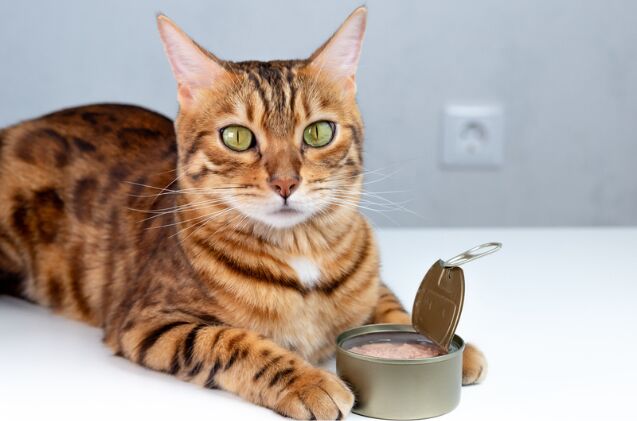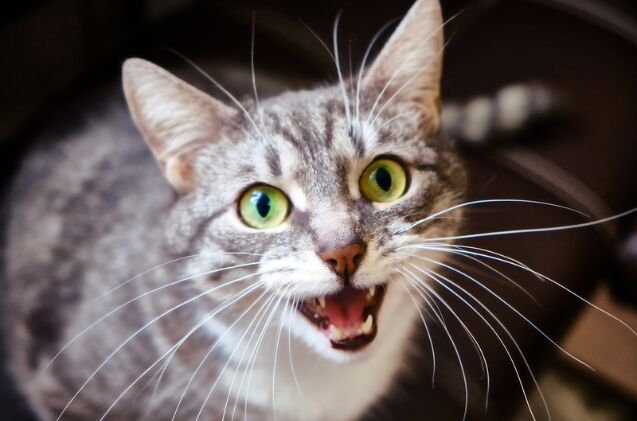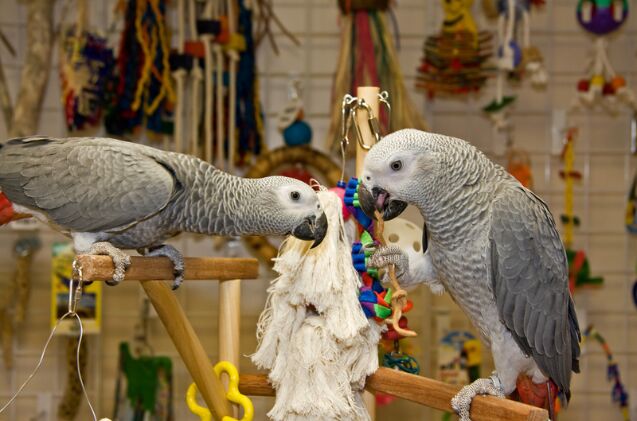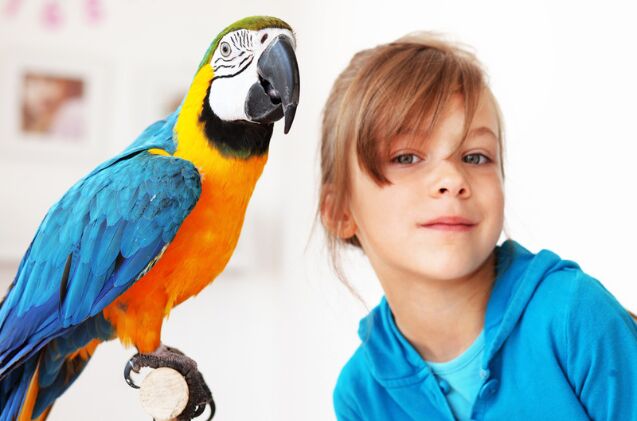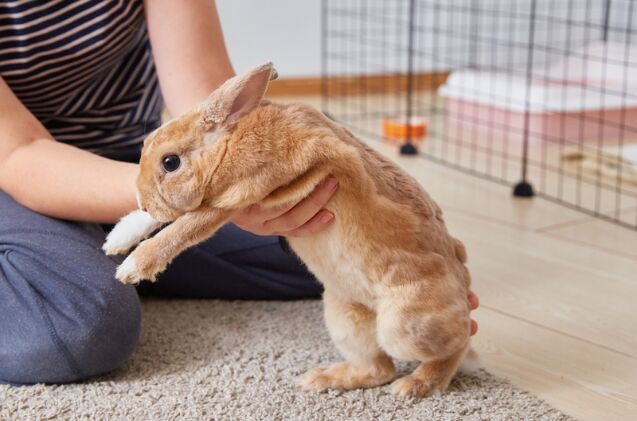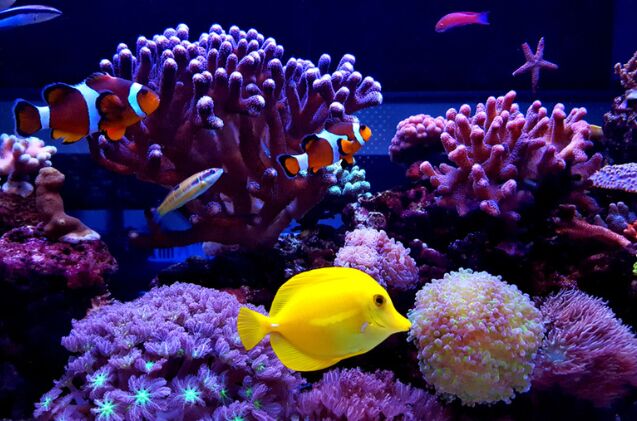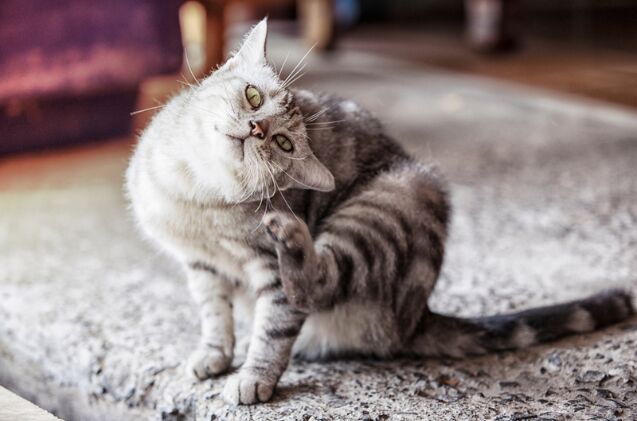Products
Cat Reunited With Owners 26 Days After Home Collapses Into River
It’s every pet parent’s worst nightmare – when Mother Nature rears her ugly head, and your pet is lost during a natural disaster. It’s a nightmare that Elizabeth Wilkins and her partner Tom Schwartz experienced firsthand when a glacial dam outburst flood sent record amounts of water down the Mendenhall River near Juneau, Alaska, last month. When the flood waters receded, two homes were complete losses, and several more were labelled as condemned.
One of the houses lost to the flood waters was the home Wilikins and Schwartz were renting. The moment the home collapsed into the river was captured by a drone recording and shared online for millions to see. You can see the video here:
Study Reveals Why Cats Are Obsessed With Tuna
Do you have a cat that goes crazy when a tuna can is opened? If so, you’re not alone! The connection between cats and tuna has long been recognized – but what is it about the canned fish that lights up their eyes and excites their tastebuds? The answer may surprise you…
A study published in Chemical Sense August 2023 reveals the secret behind this kitty addiction. Although both theories are often shared, it isn’t their known love of fish or the fact that it closely resembles canned cat food. Instead, it comes down to the way in which a cat’s tastebuds work and how that impacts the way that they taste their food.
Your cat’s sense of taste varies considerably from your own. For example, while people are often known to suffer from a sweet tooth, cats are ambivalent about sugar. They don’t prefer that sweet taste (like we usually do) but don’t avoid it. Why? It’s simple: they can’t taste it! Experts theorize that the cat lost the ability to taste sugars because it wasn’t a necessary aspect of their survival in the wild – they didn’t NEED the sugary foods, so their sweet taste receptor gene didn’t need to continue to develop and function.
“Since discovering that cats don’t have a functional sweet taste receptor, we did wonder what they would respond to instead,” explained Scott McGrane, sensory science expert at the Waltham Petcare Science Institute and the study’s lead author.
They discovered that cats were particularly attracted to umami, an often-overlooked taste category alongside sweet, salty, or bitter. This taste category is better known as “savory.”
Humans have dedicated receptor cells that detect the presence of the organic compound Carboxylic Acid. If the compound is present, we taste the food as savory. However, when detecting umami, a cat’s taste receptors bind to two different chemicals. These chemicals are present in high concentrations in tuna, giving it an even more robust savory flavor. The concentration is even higher in tuna than in other fish species, making it particularly tempting for our feline friends.
The team conducted a taste test with 25 subjects as part of the study. To test their taste receptors and how they impacted the cats’ preferences, they set up a series of water bowls with varying amounts of organic compounds, including nucleotides and amino acids, and a control bowl of water.
When allowed to explore the bowls, researchers noted that the cats were most attracted to the combinations that activated the umami receptors – the “savory bowls.”
What does this development mean for your cat and the development of cat products in the future? Understanding the attraction to savory foods, especially tuna, pet food manufacturers are better able to formulate diets that will appeal to their tastebuds. This means creating foods that our cat will actually WANT to eat.
This could be a powerful shift for those navigating medical conditions that trigger a loss of appetite. By offering a food they are more tempted to eat, they can encourage their cat to take in the nutrition needed for a full recovery.
Why is My Cat So Talkative?
Do you have a cat that is constantly vocalizing and making themselves known around your house? Whether it is a sweet, melodic purr, a high-pitched chirp, or a loud and obnoxious meow, there is no denying that our cats have a language all their own. The only challenge? Unless you know how to “talk cat,” you’re always just outside the conversation… What exactly are they trying to say?
In this post, we will take a deep dive into the world of cat communication, including understanding why your cat is so chatty, what subtle nuances you should pay attention to, and how your cat’s talkative personality can strengthen your bond.
Let’s get started…
4 Possible Explanations for a Talkative Cat
Just like humans, your cat may be trying to have a conversation for many reasons. Think about how many times you talk or vocalize throughout the day – you may ask for attention from a family member, share your thoughts about a given situation, or use your words to ask for something you want. The same can be said for your cat.
While it can be challenging to identify exactly what your cat is trying to say in some situations, it starts with understanding the most common reasons for a cat's vocalizing.
They Are Asking for Something Specific
Pay attention to where your cat is when making noise and what they may be staring at or pacing around. We can often identify what our cat is asking based on their behavior. A hungry cat may be very vocal while looking at an empty food dish until someone acknowledges their request and fills the bowl.
Some of the more common requests and the body language that accompanies their vocalizations include:
- Food and Water Refills: They may be nosing at the dish, pawing at it, or pacing around where they are regularly fed.
- Asking for Treats: We keep our treats on a specific shelf in the kitchen, and the cats can usually be found staring up in that direction when they are asking for something special.
- Play Time: Our girl Pippen can often be seen walking around with a toy in her mouth while making noises to get us to take it and play fetch with her.
- Wanting to Go Outside: Our cats are harness-trained, and their leashes and harnesses hang near the front door. They meow while pawing at the hanging leash when they want to go outside.
If you hear your cat meowing or chirping, follow the noise. Find out where they are and what they are doing, allowing the clues to help you better understand what they are trying to tell you.
They Are Seeking Attention
Does it appear that your cat is meowing relentlessly with no rhyme or reason for their actions? Do you have a cat that just walks around the house, meowing at various times throughout the day? There is a good possibility that your cat is simply trying to demand your attention.
Some cats are far more social than others and need to spend quality time with you or the other pets in your home. Think of it like an introverted person versus an extroverted person. While the introverted person may be happy hanging out at home without talking to anyone for a while, the extroverted person will start to go crazy needing social interactions. We often see Jinx doing this, specifically focusing on the loft area of the home that is only accessible to our cats, making it clear that she isn’t even calling us – she’s calling for the attention of our other cat.
They May Be in Heat
Do you have an unaltered female cat? One of the signs that your cat is going into heat is that they will begin to make a loud, yowling sound. This is an effort to call out to a potential mate. If you suspect that your cat may be in heat, keep them safely contained indoors, away from any unaltered males, to avoid an unwanted litter.
Celebrities Who Adopted Their Animal Co-Stars
With the number of pets being abandoned and turned over to rescues and animal shelters reaching new highs, there has been a lot of chatter about the importance of the “adopt, don’t shop” movement. According to the ASPCA, approximately 6.3 million companion animals enter animal shelters in the United States annually – a startling and mind-blowing number.
There have been many unique ways to help get these incredible animals out of the shelters. One that the average pet lover may not realize is the number of television shows and movies that bring on adoptable animals as furry co-stars on the set.
You may wonder, if these animals are searching for their forever home, why was something not said to the general public?
The truth, in many cases, is quite heartwarming! Many of these animals are adopted right off the set by their costars or others working on the movies. This includes adoptions involving some of our favourite celebrities! Here are a few such happy endings…
Chris Evans and Dodger
While on the set of his 2017 film, Gifted, Chris Evans was introduced to a high-energy and loving 1-year-old dog that was an “extra” during a scene filmed in a kennel setting. After discovering that this pup was up for adoption, it didn’t take long for Evans to know it was meant to be. Today, Evans reports that Dodger plays an essential role in his daily routine, including cuddling up together to sleep and regularly exercising together.
Sophie Turner and Zunni
Quite a few animals were seen on the Game of Thrones set, but one in particular had a happy ending. Her character’s direwolf Lady may have died on the show, but that certainly wasn’t the end of the bond and connection between these two. Turner convinced her parents to welcome Zunni into the family.
Sylvester Stallone, Cuff, and Link
Looking back a little further into the history of pets adopted off the set, Cuff and Link were adopted back in 1976 from the set of Rocky. These two have enjoyed a long, happy life in the Stallone household. While it’s unclear whether they are still alive today, Stallone did share a post in 2019 featuring the 44-year-old turtles. They also made a cameo appearance in CREED 2.
Sarah Jessica Parker and Lotus
A more recent adoption, Lotus joined the Parker/Broderick family in April 2023, having been adopted off the set of Season 2 of And Just Like That… In the show, Lotus played Shoe, Carrie Bradshaw’s cat. Not only has Lotus been adopted to spend the rest of his life with Parker, but he will continue to start on the show alongside her.
Taylor Swift and Benjamin Button
This may not be an example of a show or movie set, but Benjamin Button’s claim to fame was his role in Swift’s music video for ME! In 2019. When the cat was played in Swift’s arms to film the scene together, he started purring and snuggling into her. He knew right away this was his forever person, and it didn’t take long for Swift to reciprocate those feelings.
Is My Pet Bird Bored in Their Cage?
As a devoted bird parent, you want to give your feathered family members the best possible quality of life. This includes setting up a cozy cage with everything they need, feeding high-quality foods, and spending time building your bond together. But have you ever wondered whether your pet bird is bored in their cage?
Just like humans, birds can experience moments of boredom and restlessness. When unaddressed, it can lead to behavioral issues. We’re here to help! Avoid problems and provide your bird with the entertainment and mental enrichment they need by following these 9 tips:
Does a Bird Get Bored in a Cage?
Yes, they definitely can! When people are introduced to raising and caring for birds, we often stress the importance of a secure, comfortable cage for them to live. While this habitat is essential, focusing specifically on the cage may have set many bird parents up for failure. Why? Because simply having a nice cage isn’t enough to keep your bird happy. For the best quality of life, you must find ways to provide mental enrichment opportunities for your bird.
How Can You Tell if Your Bird is Bored?
One of the best things you can do for your bird’s mental health and happiness is learn how to identify if your bird is bored. By recognizing the symptoms early, you can then make changes to your bird’s lifestyle, routine, and habitat to address the problem head-on.
The sooner you eliminate the boredom, the more likely you are to prevent any potential problems that boredom may cause, such as self-destructive behaviors, aggression, or damaging your home and belongings. Ultimately, if a bird is left to feel bored or lonely for too long, it can seriously impact their overall well-being, leading to health problems and potentially loss of life.
The most common signs that a pet bird is bored include:
- Excessive screaming and vocalization
- Pacing
- Withdrawal or uncharacteristic reluctance to be handled
- Sudden lack of activity
- Weight gain and obesity
- Biting or lashing out
- Feather plucking or skin picking
- Loss of appetite
- Appearance of stress bars on your bird’s feathers
If you notice any of these signs or any other sudden and unexplained behavioral changes, you should start with a call to your avian veterinarian. Explain your concerns and the changes that you have noticed. They can make an appointment to run tests and rule out potential medical explanations for the behavior.
Once you are sure there is no medical cause for your bird’s behavior, you can focus on providing new enrichment and entertainment opportunities.
When Should I Set Up a Quarantine Tank for My Fish?
If you are new to fishkeeping, you have likely noticed that there is a lot more involved in setting up a healthy, thriving aquarium than most people realize! From the ideal tank setup to managing water levels, there is much to learn – including the basics of fish health. One topic that is often overlooked but can be incredibly important in terms of your tank health is the use of a quarantine tank.
But what is a quarantine tank, and when should it be used?
In this post, we will look at how a quarantine tank can improve the overall health of your existing aquarium, including how to set up, maintain, and disinfect your quarantine fish tank.
What is a Quarantine Tank?
Before we dig into the finer details, let’s start at the beginning – what is a quarantine tank? Quarantine fish tanks are smaller tanks set up to help limit the potential spread of illness or disease. They do this by effectively quarantining the sick (or potentially sick) fish separate from the main tank or aquarium.
Think of the tank like a human hospital. If a person is suspected of possibly having an infectious disease, steps are taken to prevent that disease from spreading to anyone else. This includes removing the person from the general public, limiting access to them, and maintaining a clean and sterile environment.
In the same way, your quarantine tank isn’t going to be set up as a fancy, decorative area. Instead, the focus is put on eliminating anything that could increase the transmission of disease. For this reason, they are often free from decorations and aquarium gravel or other forms of substrate. This allows you to create a clean and stress-free area for your fish – especially if they are being treated for or recovering from an illness.
Can I Take My Rabbit on a Road Trip Safely?
As pet parents and animal lovers, we often talk about the joys of road-tripping with cats and dogs, but what about the many other pets we call family? What if you share your heart (and home) with a rabbit?
Great news! Whether you’re planning a family vacation and want to include your bunny in the fun, or you’re moving across the country and need to figure out how to transport a rabbit to your new home, taking your furry family member on the road IS possible.
To help you plan for your next big trip, we’re going to break down everything you need to know about taking a road trip with a rabbit, including the safest way to travel with your rabbit, tips for the most enjoyable trip for both you and your rabbit, and when it’s best to leave your rabbit at home with a friend, family member, or trusted pet sitter.
Let’s get started…
Is it Stressful for Rabbits to Travel?
One of the most important questions we must ask ourselves whenever we consider travelling with a pet is whether travel will bring more stress than it’s worth. If your rabbit is going to be stressed and anxious the entire time, they won’t be able to enjoy spending this time with you.
There is no one-size-fits-all answer to this question. Instead, we each need to learn to read our rabbit’s body language and recognize when they are uncomfortable in a situation.
The most common signs of stress in rabbits include:
- Ears flattened to their back
- A rigid, crouched posture
- Thumping of hind legs
- Trembling
- Restlessness
- Lethargy or lower-than-normal energy levels
- Loss of appetite or increased appetite
- Change in bathroom habits
- Loudly grinding their teeth
- Wide and bulging eyes
- Rapid, shallow breathing
- Making frustrated grunting noises
- Sudden, unexplained aggressive behavior
- Hiding or acting withdrawn
- Reluctance to be touched or held
- Loss of interest in their favorite activities
- Self-mutilation habits (excessive licking, biting, etc.)
For your first rabbit travel experience, start small. Introduce them first to the vehicle in your driveway, waiting to turn on the engine until they are comfortable with it off. You can then work up to a longer trip by starting with the engine going but sitting in the driveway, moving slightly up and down the driveway, and then taking a short trip around the block.
Throughout the conditioning process, pay careful attention to your rabbit. If you notice any of the above signs of stress, slow down and avoid moving on to the next step. This may mean, in time, acknowledging that your rabbit isn’t comfortable travelling despite your best efforts – and that’s okay! Many rabbits are happier relaxing at home and being spoiled by a loved one while you are on vacation.
Do Birds Make a Good Pet for Children?
Are you a bird lover and look forward to sharing that love with your child? Has your child recently been asking to add a bird to the family? If so, there are a few critical factors that you need to consider…
While a pet can be a great way to teach responsibility and respect for animals, not every pet is ideal for children – especially young children! At this early age, kids are still learning how to navigate the world around them. They are often loud and unpredictable, creating an uncomfortable situation for a new pet who doesn’t know or understand what to expect. This can lead to injuries to your child or your new pet.
This brings us back to the question of the day – Do birds make good pets for children? The answer isn’t as black and white as you may have hoped…
Do Pet Birds Cuddle?
One of the things we often love about spending time with a pet is the love and affection that they share. Most people think of cuddly cats and dogs when they think of snuggling up with a pet. But these furry companions aren’t the only pets that enjoy curling up with their people. In fact, some bird species thrive on physical affection.
But this isn’t true for all birds. If you’re looking for a cuddly bird, you will need to research the options available.
Parrots are well known for their affectionate personalities. When they bond with their person, they enjoy throwing their love by spending time with you, sleeping on you, preening you, and, of course, cuddling you. However, don’t overlook the significant commitment that comes with raising a parrot! The Scarlet Macaw, for example, often lives 50-75 years, but there are reports of Macaws living longer than 100 years. They also grow considerably larger than many pet birds, requiring more space for a proper habitat.
Other birds that are also known to be cuddly include:
- Lovebirds
- Canaries
- Cockatoos
- Cockatiels
- Conures
- Parakeets
- Doves
Can I Make a Homemade Rabbit Cage?
Whether you are planning to bring home your first rabbit or changing things up with a new habitat for your bunny, choosing, planning out, and designing a cage can be a fun experience. But it can also be a costly one… One way to give your rabbit the best possible habitat without breaking the bank is to take on a rabbit cage DIY project – making alterations to a store-bought cage or building one yourself from scratch.
To help you get started, I have compiled a basic guide to setting up your own homemade rabbit cage, including some basic rabbit habitat information, a few commonly asked questions about a rabbit’s ideal environment, and step-by-step instructions to build your own DIY rabbit cage.
Can Rabbits Be Kept Without a Cage?
One of the first supplies most people purchase before bringing home a rabbit is a cage, but is a traditional cage necessary? As rabbit lovers and experts have learned more about the basic needs of their furry friends, new approaches to raising a rabbit have emerged. In fact, most of the standard rabbit cages you will see in your local pet stores are too small to provide the space needed for a happy, healthy life.
Free roaming refers to giving your rabbit access to your home or apartment so they can wander freely, even if you aren’t present. This is similar to how most people raise a dog or cat.
One way to do this effectively while still maintaining a clean and sanitary home is by litter training your rabbit. Just like cats, rabbits can be trained to do their business in a designated box or area. This keeps the mess contained, making it easier to clean up. But, of course, it requires putting the work into training and being prepared to deal with any accidents that may occur during that process.
Additionally, you must consider rabbit-proofing your home to prevent unwanted or potentially dangerous bad habits like chewing on your furniture or, even worse, chewing electrical cords.
This all takes time, money, and patience. If you aren’t prepared to take on this level of commitment to maintaining a safe, free-roaming environment, it is in the best interest of everyone involved (including you and your rabbit) to keep your rabbit safely contained in a suitable cage or pen.
Can TV For Your Dog Actually Ease Anxiety?
We all love television entertainment, but have you ever considered that your canine companion might appreciate their own curated TV experience? Enter DOGTV, a unique service that takes television to a whole new level—tailored specifically for dogs. Offering 24/7 streaming designed to alleviate your pup's stress and anxiety, DOGTV isn't just a TV channel; it's a dedicated canine wellness brand.
Do I Need Gravel in My Fish Tank or Aquarium?
Are you newer to fish keeping or considering setting up your first aquarium? If so, you likely already have many questions - there is much to consider! However, unlike adopting a dog or a cat, most pet stores will sell fish without offering too much information about how to set up the best tank or aquarium for their long-term health and well-being. If you’re feeling overwhelmed or confused, you’re not alone.
When I decided to set up my first fish aquarium, I had very little information to go on. Until that point in my life, the only fish I cared for were goldfish in a less-than-ideal goldfish bowl setup. Of course, at that time, I didn’t know better. However, having researched and learned more about their needs and the ideal environment, I was committed to creating the best environment for my new fish friends. The problem was, I wasn’t sure what that meant…
One product that I saw everywhere I looked was aquarium gravel, but I quickly realized that not all gravel is created equal. Even more perplexing, not all aquariums had gravel or SHOULD have gravel.
To help you navigate the many options available and get started with your aquarium on the right foot, I wanted to share some vital information about the use of gravel in fish tanks and aquariums, including the answer to whether you need gravel in your fish tank, the best gravel substrate to use, and some basic care tips for maintaining the gravel in your tank moving forward.
What is Aquarium Gravel?
Aquarium gravel refers to the small rocks or pebbles at the bottom of a fish tank or aquarium. They can vary significantly in size and color. Colourful gravel, as you often see in beginner fish tank sets or children’s fish tanks, can add a fun element to the visual appearance of the tank. However, many experts warn that the bright colors, while appealing to children, may be distracting or upsetting for the fish. For this reason, these experts often recommend a more neutral color or natural-looking gravel option.
How much truth is in that statement is still unknown. What we do know is that many of the more ornamental and popular fish, like goldfish, don’t appear to be bothered by the vibrant stones. But we do know that the quality of your gravel, regardless of its appearance, is important. Cheaply made and mass-produced aquarium gravels often flake off bits of paint over time, adding toxins and particles to the water that could make your fish sick.
When choosing aquarium gravel, try to avoid the cheapest products available. Instead, look for a well-known and trusted brand. Rinse off the gravel before using it, removing any flakes that may have come off during transport. Finally, as you’re cleaning your fish tank or aquarium, pay attention to signs of wear that may indicate it’s time to replace your substrate.
Can I Convert My Freshwater Aquarium Into a Saltwater Aquarium?
Freshwater aquariums are often the starting point for those new to fishkeeping. It’s a lower-cost entry point and generally more forgiving than saltwater aquariums as you learn the ins and outs of maintaining your tank.
But what if you started with a freshwater aquarium but are now ready to switch? Must you purchase everything from scratch to set up a new aquarium? It’s a question that we hear often. The good news is that you CAN convert a freshwater aquarium into a saltwater aquarium with some planning, preparation, and a few key steps.
This article will discuss the pros and cons of having a saltwater aquarium and some other essential information to help you decide if this is right for you and your fishkeeping journey.
If you are ready to make the change, we’ve also included a step-by-step guide to switch your tank over properly. Let’s get started…
Can You Put Saltwater Fish in a Freshwater Aquarium?
If the reason you are considering changing to a saltwater aquarium is a love of the bright, colorful fish, you may be wondering if you can simply place the new fish in your current aquarium setup.
Spoiler alert: Don’t do that!
Saltwater fish have adapted and evolved to thrive in environments with a high salt concentration. This means changes in their bodies at a cellular level and how their bodies process water to eliminate the excess salt.
When placed in freshwater, they cannot adjust to the new environment. As they take in the water, their cells absorb it through osmosis, causing them to swell. Ultimately, this is a fatal mistake. If you want your saltwater fish to survive, let alone thrive, you must ensure that they are in a saltwater environment.
What Are the Benefits of Snuffle Mats for Dogs?
Our Snuffle Mat of Choice: The Pet Parents Forager Mats
I would be lying if I pretended that we don’t have a collection of different snuffle mats here at the house, including an assortment of sizes, colors, and styles. The truth is that we love the option to feed our dogs with snuffle mats, and that has led us to try many different options – including several that we love and a few that fell short of our expectations. However, one mat has stood out above the others in terms of its quality, washability, and functionality, and that’s the Pet Parents Forager Mat.
With our girl Daviana being older, her eyesight is starting to fail. Feeding her in a snuffle mat is an excellent way to challenge her mind without risking her hitting her nose off a hard puzzle feeder that she can’t see to solve. Unfortunately, it also means that she tends to rub her nose around on the material even more than our younger boys, and with some of the felt snuffle mats, that can leave her nose raw and painful.
The soft material of the Forager mats is very forgiving as she sniffs about. Meanwhile, the non-slip back ensures that it stays put so that she doesn’t have to worry about it sliding (and her slipping with it).
Our favorite part about this particular mat is its convenience for travel as we often spend our time in campsites across the province. The mat rolls up easily with a strap to hold it in place, making it easy to bring wherever the road takes us. When feeding the pups in the tent or the vehicle on a rainy day, it helps to keep our space clean – even when you have a slobbery dog. Indiana has been known to make quite the mess with his food and water, but this mat just soaks it up and keeps everything contained. Throw it in the wash when we get home, and we’re ready to go.
Our boys are speed eaters, and offering meals in this mat has slowed them down considerably.
Final Thoughts: The Benefits of Snuffle Mats for Dogs
Whether you’re searching for an easy solution to slow down the speed eater in your life or simply looking for a way to offer mental enrichment with your dog’s meal, a snuffle mat is a great solution. They tap into your dog’s natural desire to forage for their food, challenging their mind and encouraging them to use their strong sense of smell. It’s a great way to take your dog’s meal to the next level!
Survey Reveals the Most Common Pet-Related Myths Pet Parents Believe
With the growing wealth of online information, the answers to all your questions are just a click away – but how much of that information can be trusted? There have always been myths and misconceptions within the pet industry, but experts warn that this misinformation is bigger than ever.
A recent study conducted by OnePoll with Stella & Chewy’s, a well-respected pet food brand, revealed that a startling 92% of pet parents still believe myths about their pets.
These common myths include everything from basic pet anatomy, overall health and wellness, dietary needs and concerns, and basic pet care. While some of these myths are harmless, just a funny misunderstanding, others can have a significant impact on your pet’s health and well-being. In fact, of the 2000 survey participants, nearly half reported that knowing how to best care for their pet with the conflicting information available can be difficult.
For example, it has long been stated that a cold, wet nose on a dog means that they are in good health, with 38% believing this outdated information. The truth is that your dog’s nose likely only feels wet because your dog recently licked it. While this can improve their sense of smell, it’s not a reliable indicator of your dog’s health.
Some other pet care myths addressed by the survey include:
- 42% of cat parents believe their cat can see in complete darkness. They CAN see in very low light conditions, but not in a complete absence of light.
- 41% of cat parents believe that cats always land on their feet. The hard truth is that your cat is more likely to land on their feet, but it can be impacted by many critical factors, including their overall health. Conditions that affect their balance or mobility may prevent them from landing safely.
- 29% of cat parents believe that cats enjoy milk. Cat’s milk (which can be purchased at many pet stores) is a great option, but many cats are actually lactose intolerant.
- 68% of dog parents believe a wagging tail is always a sign of happiness. This body language is essential for dog lovers to understand because, depending on how your dog’s tail is wagging and other body language indicators, it could mean your dog is overly alert or stressed.
In addition to exploring these basic pet care myths, the survey then drilled down into even more diet and nutrition-focused questions.
More than a quarter of the dog parents surveyed believed homemade pet foods are always healthier than store-bought diets. But this fails to address the importance of proper nutritional balance and the fact that many homemade meals created by well-meaning pet parents may lead to nutritional deficiencies. Of the cat parents surveyed, 30% believed it wasn’t safe for their cats to eat any human food. But some human foods are not only safe; they could also help support your cat’s health or address specific health conditions. For example, pumpkin has been found to improve digestion and even manage hairballs naturally.
Can My Cat Get an Ear Infection?
I’ve you’ve ever found yourself wondering, “Can my cat get an ear infection?” – You’re not alone! As loving cat parents, we strive to provide our feline friends with the best possible quality of life, including staying informed about their health.
Yes, ear infections in cats can indeed occur, and they can cause our cats a lot of discomfort and distress. If left untreated, they can even lead to permanent hearing problems.
In this article, we will explore the ins and outs of feline ear infections, shedding light on the possible causes, common symptoms to watch out for, and how to best protect your cat’s delicate ears. You’ll walk away feeling empowered to ensure your cat can enjoy a cozy, comfortable, and infection-free life.
What is the Most Common Ear Infection in Cats?
The good news is that ear infections are far less common in cats than dogs. But this doesn’t mean they don’t occur or shouldn’t be taken seriously. The types of ear infections a cat may suffer from can be sorted into three categories based on the location in the ear where they occur. This includes outer ear infections, middle ear infections, and inner ear infections.
The most common type of outer ear infection is ear mites. These tiny parasites live on the skin's surface and inside the ear canal. These microscopic pests are uncomfortable and irritating, often causing cats to scratch at their ears until the outer ear is inflamed. They also leave behind debris that can build up within the ear, adding to the irritation.
Inner ear infections are often the result of a bacterial infection. There are several different causes that can lead to the introduction of bacteria to your dog’s ears, including a less serious outer ear infection left untreated. These infections are far less common but are the most damaging if left unaddressed, as they can permanently alter your cat’s hearing.




